Monfragüe: Galería multimedia
Monfragüe: Galería multimedia
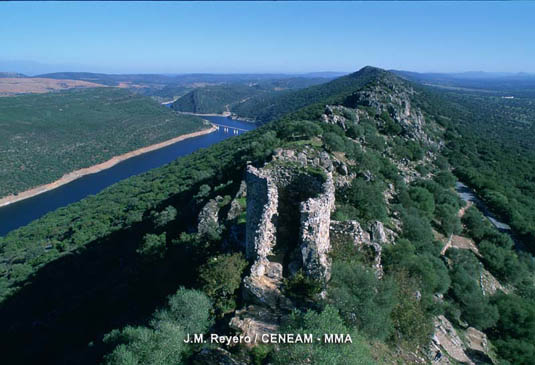 El castillo ha sido utilizado por los diferentes pueblos que han pasado por esta zona por su privilegiada posición. Se lenvanta sobre un escarpado monte sobre el río Tajo.
El castillo ha sido utilizado por los diferentes pueblos que han pasado por esta zona por su privilegiada posición. Se lenvanta sobre un escarpado monte sobre el río Tajo.
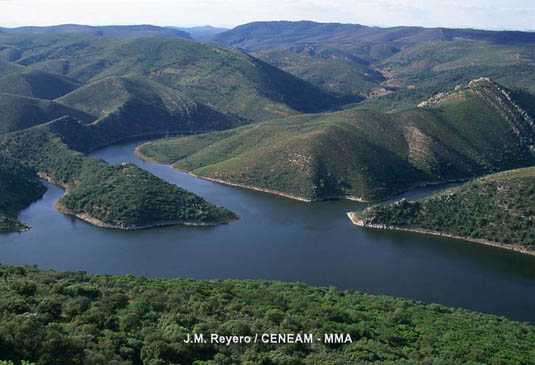 Uno de los enclaves más bellos del Parque Nacional, visible desde lo alto del Castillo, es la confluencia de los arroyos Barbaón y Malvecino en el río Tajo.
Uno de los enclaves más bellos del Parque Nacional, visible desde lo alto del Castillo, es la confluencia de los arroyos Barbaón y Malvecino en el río Tajo.
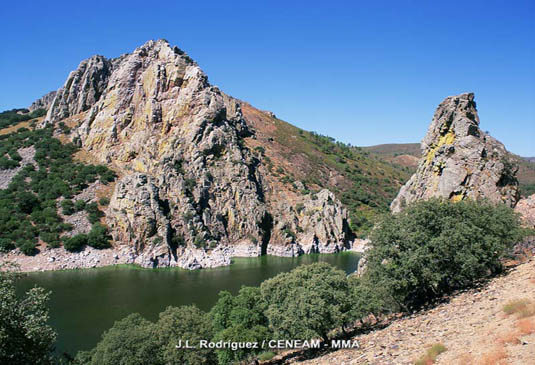 El salto del gitano es uno de los lugares más emblemáticos del Parque Nacional, donde puden verse especies tan singulares, como la cigueñas negra (Ciconia nigra) o el alimoche (Neophron percnopterus).
El salto del gitano es uno de los lugares más emblemáticos del Parque Nacional, donde puden verse especies tan singulares, como la cigueñas negra (Ciconia nigra) o el alimoche (Neophron percnopterus).
 Las cuarcitas, son las rocas que marcan y caracterizan la estructura del parque. Sierra de Santa Catalina con Peñafalcón en primer plano.
Las cuarcitas, son las rocas que marcan y caracterizan la estructura del parque. Sierra de Santa Catalina con Peñafalcón en primer plano.
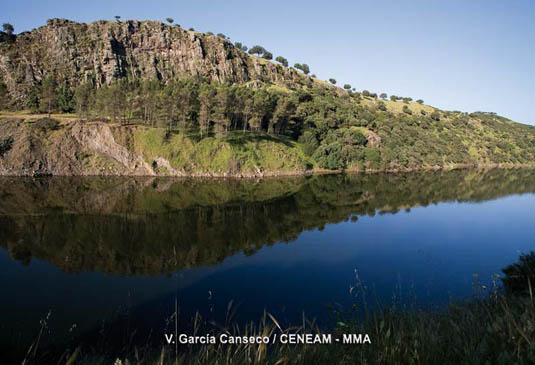 El Mirador de Tajadilla sobre el río Tietar, es uno de los puntos más visitados del parque.
El Mirador de Tajadilla sobre el río Tietar, es uno de los puntos más visitados del parque.
 Sierra de las Corchuelas y río Tajo embalsado.
Sierra de las Corchuelas y río Tajo embalsado.
 El castillo de Monfragüe es una fortaleza en ruinas que data de la época árabe. Con la conquista posterior de los cristianos, sufrió algunas remodelaciones.
El castillo de Monfragüe es una fortaleza en ruinas que data de la época árabe. Con la conquista posterior de los cristianos, sufrió algunas remodelaciones.
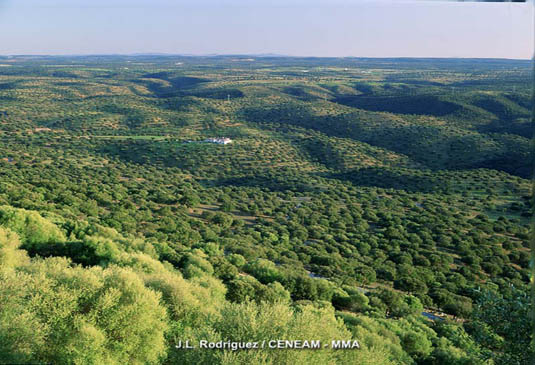 Las dehesas son el paisaje dominante del entorno del Parque Nacional. Este ecosistema juega un papel fundamental en la conservación de este espacio natural.
Las dehesas son el paisaje dominante del entorno del Parque Nacional. Este ecosistema juega un papel fundamental en la conservación de este espacio natural.
 Las dehesas juegan un importante papel como fuente de alimento para multitud de animales.
Las dehesas juegan un importante papel como fuente de alimento para multitud de animales.
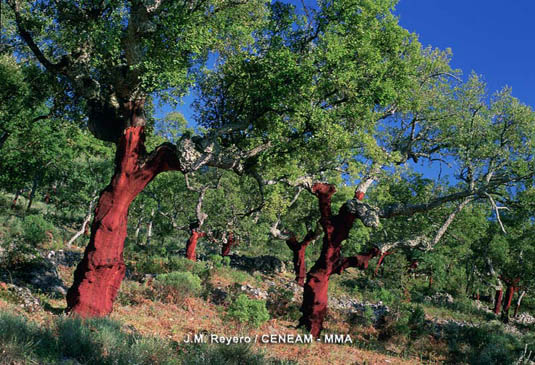 La saca del corcho está perfectamente regulada por el por el Plan de Ordenación de Recursos Naturales del Parque Nacional.
La saca del corcho está perfectamente regulada por el por el Plan de Ordenación de Recursos Naturales del Parque Nacional.
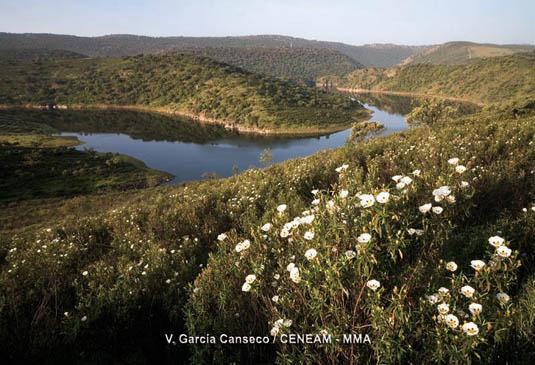 Las laderas más secas donde ha desaparecido la vegetación arbórea, aparecen cubiertas sobre todo, de jaras pringosas (Cistus ladanifer).
Las laderas más secas donde ha desaparecido la vegetación arbórea, aparecen cubiertas sobre todo, de jaras pringosas (Cistus ladanifer).
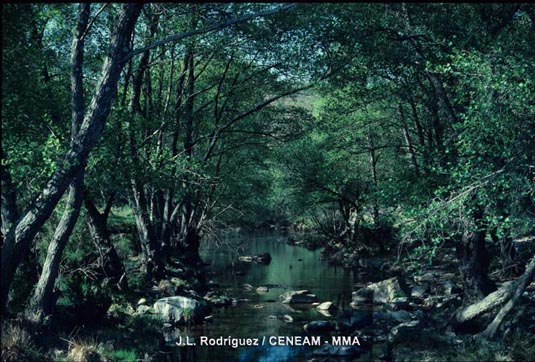 Los arroyos, con sus bosques de alisos (Alnus glutinosa) constituyen un ecosistema esencial para el desarrollo de muchas especies.
Los arroyos, con sus bosques de alisos (Alnus glutinosa) constituyen un ecosistema esencial para el desarrollo de muchas especies.
 Roquedo y retamas de escobas (Genista polyanthos) en flor.
Roquedo y retamas de escobas (Genista polyanthos) en flor.
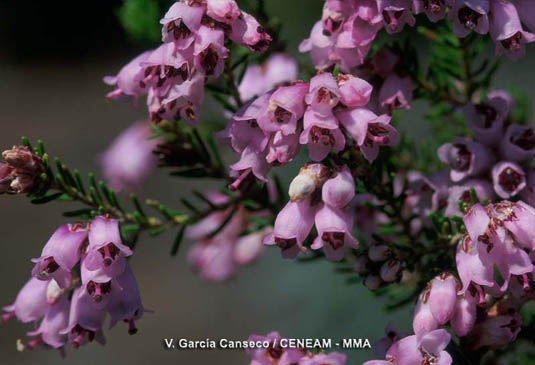 El brezo colorado (Erica australis) florece al principio de primavera sobre suelos pobres y húmedos.
El brezo colorado (Erica australis) florece al principio de primavera sobre suelos pobres y húmedos.
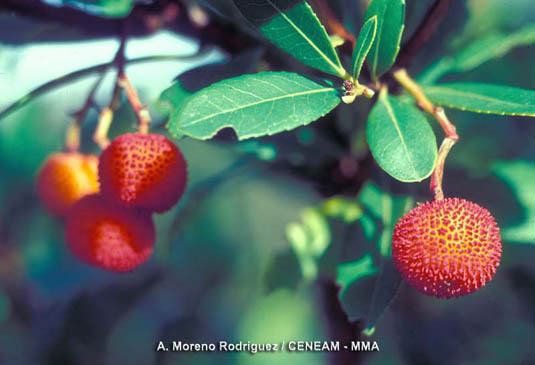 En las umbrías del parque podemos encontrar el madroño (Arbutus unedo).
En las umbrías del parque podemos encontrar el madroño (Arbutus unedo).
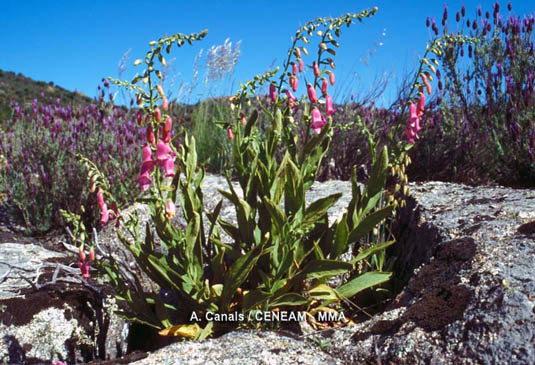 La dedalera (Digitalis thapsi), es una planta exclusiva de la Península Ibérica. Vive en zonas pedregosas soleadas.
La dedalera (Digitalis thapsi), es una planta exclusiva de la Península Ibérica. Vive en zonas pedregosas soleadas.
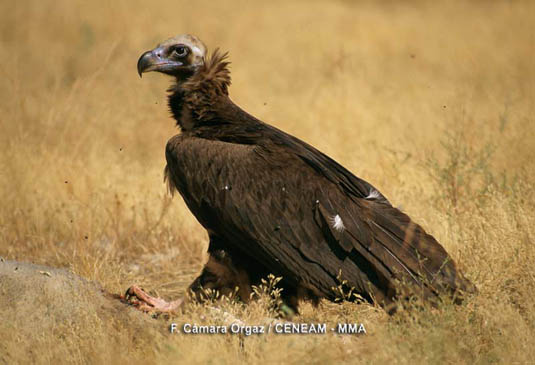 En Monfragüe se asienta la colonia de buitres negros (Aegypius monachus) más importante de España.
En Monfragüe se asienta la colonia de buitres negros (Aegypius monachus) más importante de España.
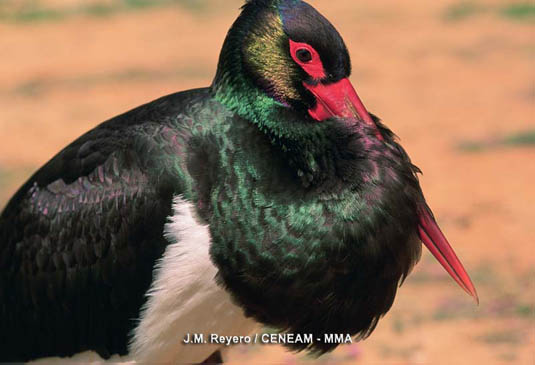 Con la llegada de la primavera, se puede ver anidando en cortados rocosos y en árboles a solitaria y esquiva cigueña negra (Ciconia nigra).
Con la llegada de la primavera, se puede ver anidando en cortados rocosos y en árboles a solitaria y esquiva cigueña negra (Ciconia nigra).
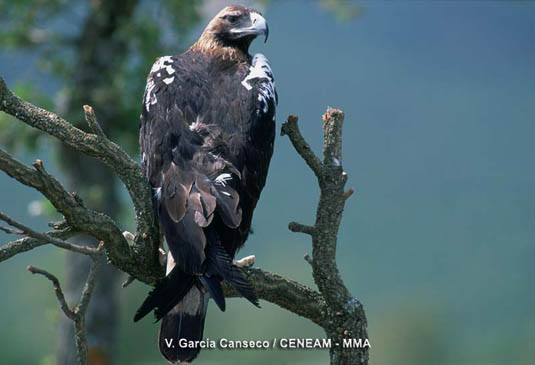 Aguila imperial ibérica (Aquila adalberti) es un especie en peligro de extinción, que en los últimos años está aumentando sus efectivos en Mofragüe y en el resto de la Península Ibérica.
Aguila imperial ibérica (Aquila adalberti) es un especie en peligro de extinción, que en los últimos años está aumentando sus efectivos en Mofragüe y en el resto de la Península Ibérica.
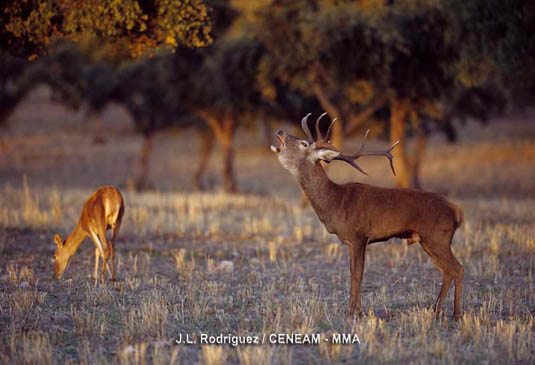 Con la llegada del otoño, se produce la berrea del ciervo, fenómeno que cada vez atrae a mayor número de visitantes al parque nacional.
Con la llegada del otoño, se produce la berrea del ciervo, fenómeno que cada vez atrae a mayor número de visitantes al parque nacional.
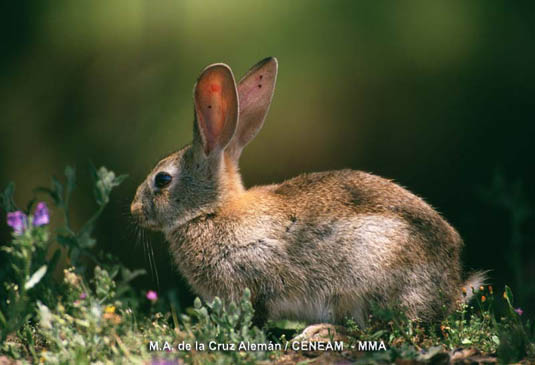 El conejo (Oryctolagus cuniculus) constituye la presa principal de muchos de los depredadroes de Monfragüe.
El conejo (Oryctolagus cuniculus) constituye la presa principal de muchos de los depredadroes de Monfragüe.
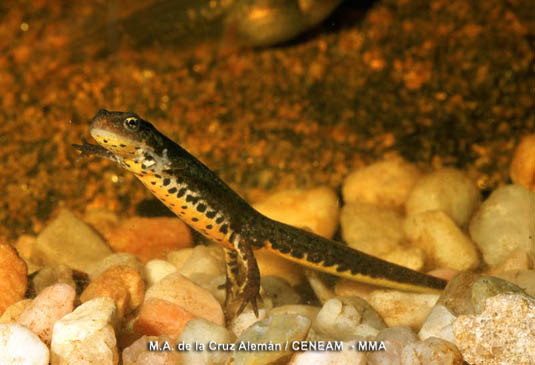 El tritón ibérico (Lissotriton boscai), es un anfibio endémico de la mitad occidental de la Península Ibérica. En el parque se le puede ver en muchos cursos de agua.
El tritón ibérico (Lissotriton boscai), es un anfibio endémico de la mitad occidental de la Península Ibérica. En el parque se le puede ver en muchos cursos de agua.
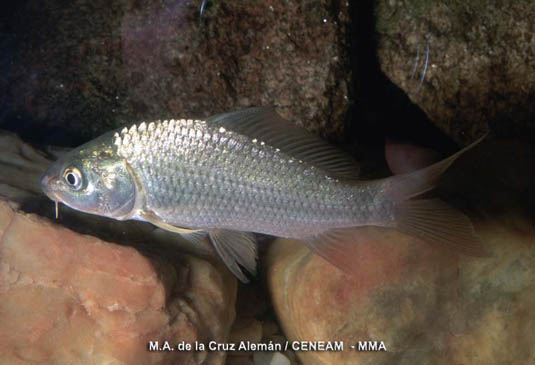 La carpa (Cyprinus carpio) es uno de uno de los peces que puebla los embalses de Monfragüe.
La carpa (Cyprinus carpio) es uno de uno de los peces que puebla los embalses de Monfragüe.
 Con un poco de paciencia y suerte, podemos llegar a observar muchas de las aves de este enclave natural.
Con un poco de paciencia y suerte, podemos llegar a observar muchas de las aves de este enclave natural.
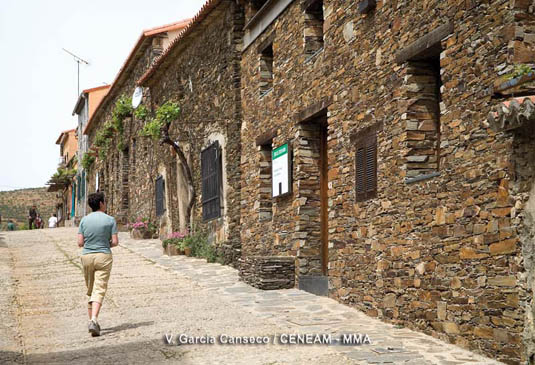 Los pueblos del entorno del Parque Nacional han tenido un importante incremento en el numero de visitantes en los últimos años, esto ha supuesto una mejora del nivel económico en la comarca.
Los pueblos del entorno del Parque Nacional han tenido un importante incremento en el numero de visitantes en los últimos años, esto ha supuesto una mejora del nivel económico en la comarca.
This page provides information on cookies we use: We use our own and third-party cookies to keep your session active, personalise your experience, and collect anonymous statistics about how you use this website. You can choose to accept all cookies or select which types you'd like to allow. To learn more about the cookies we use, read our Cookies Policy.
We use two types of cookies on this site. First, there are Functional Cookies, which are essential for the website to work properly. They store session data to make your experience smoother and more convenient. On the other hand, Analytical Cookies collect information about how you use the portal, without personal data, helping us provide a better and more tailored service.
Introduction to the Use of Cookies on the MITECO.gob.es Website
Cookies are small files that are stored on your device when you visit a webpage. They are essential tools that help provide many of the services available on the information society. Among other things, cookies allow a webpage to store and retrieve information about a user's browsing habits or their device. Based on this information, they can be used to recognise the user and enhance the service provided.
Types of Cookies
Depending on the entity that manages the domain from which the cookies are sent and processes the data, there are two types of cookies: first-party cookies and third-party cookies.
There is also a second classification based on how long the cookies remain stored in the user's browser: session cookies and persistent cookies.
Finally, cookies can also be classified into five types based on the purpose for which the data is processed: technical cookies, personalisation cookies, analytics cookies, advertising cookies, and behavioural advertising cookies.
For more information on this, you can refer to the Guide on the use of cookies from the Spanish Data Protection Agency.
Cookies used on the website
The web portal of the Ministry for Ecological Transition and the Demographic Challenge uses Adobe Analytics, an analytics tool that helps website and application owners understand how visitors interact with their content. Adobe Analytics uses a small number of cookies to collect data and generate usage statistics for websites. This information is sent anonymously and is not shared with third parties under any circumstances. You can choose to accept or reject these cookies, as they do not affect the portal’s functionality. However, they help provide valuable information that allows us to offer a better and more tailored service. For more information about Adobe Analytics cookies and privacy, please refer to the following links:
Additionally, pages featuring content from social network X will only set cookies if the user is logged into the X site. For more details on these cookies, please refer to the following link: Privacy on Social Network X
Finally, a technical cookie named MITECO-compliance is stored, which is a first-party, technical, and session-based cookie. It manages user consent for the use of cookies on the website, remembering which users have accepted them and which have not, ensuring that those who have accepted are not shown cookie consent messages at the top of the page. This cookie is essential for the proper functioning of the portal.
Cookies Policy Acceptance / Rejection
The Ministry for Ecological Transition and the Demographic Challenge gives you the option to accept or reject cookies that are not essential for the portal's operation. Upon accessing the portal, a message will be displayed in the centre of the page with information about the cookie policy and the following options:
· Firefox
· Chrome
· Safari